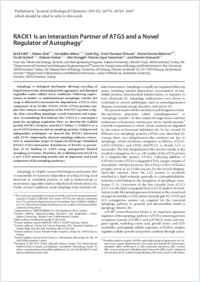RACK1 is an interaction partner of ATG5 and a novel regulator of autophagy
- Erbil, Secil Molecular Biology, Genetics and Bioengineering Program, Sabanci University, Istanbul, Turkey
- Oral, Ozlem Molecular Biology, Genetics and Bioengineering Program, Sabanci University, Istanbul, Turkey
- Mitou, Geraldine Molecular Biology, Genetics and Bioengineering Program, Sabanci University, Istanbul, Turkey
- Kig, Cenk Molecular Biology, Genetics and Bioengineering Program, Sabanci University, Istanbul, Turkey
- Durmaz-Timucin, Emel Molecular Biology, Genetics and Bioengineering Program, Sabanci University, Istanbul, Turkey
- Guven-Maiorov, Emine Department of Chemical and Biological Engineering, Koc University, Istanbul, Turkey - Center for Computational Biology and Bioinformatics, Koc University, Istanbul, Turkey
- Gulacti, Ferah Molecular Biology, Genetics and Bioengineering Program, Sabanci University, Istanbul, Turkey
- Gokce, Gokcen Molecular Biology, Genetics and Bioengineering Program, Sabanci University, Istanbul, Turkey
- Dengjel, Jörn Department of Biology, University of Fribourg, Switzerland
- Sezerman, Osman Ugur Department of Biostatistics and Medical Informatics, School of Medicine, Acibadem University, stanbul, Turkey
- Gozuacik, Devrim Molecular Biology, Genetics and Bioengineering Program, Sabanci University, Istanbul, Turkey
-
08.05.2016
Published in:
- Journal of Biological Chemistry. - 2016, vol. 291, no. 32, p. 16753–16765
autophagy
lysosome
mammalian target of rapamycin (mTOR)
protein-protein interaction
signaling
ATG12-5-16
ATG5
RACK1
p70S6K
English
Autophagy is biological mechanism allowing recycling of long-lived proteins, abnormal protein aggregates, and damaged organelles under cellular stress conditions. Following sequestration in double- or multimembrane autophagic vesicles, the cargo is delivered to lysosomes for degradation. ATG5 is a key component of an E3-like ATG12-ATG5-ATG16 protein complex that catalyzes conjugation of the MAP1LC3 protein to lipids, thus controlling autophagic vesicle formation and expansion. Accumulating data indicate that ATG5 is a convergence point for autophagy regulation. Here, we describe the scaffold protein RACK1 (receptor activated C-kinase 1, GNB2L1) as a novel ATG5 interactor and an autophagy protein. Using several independent techniques, we showed that RACK1 interacted with ATG5. Importantly, classical autophagy inducers (starvation or mammalian target of rapamycin blockage) stimulated RACK1-ATG5 interaction. Knockdown of RACK1 or prevention of its binding to ATG5 using mutagenesis blocked autophagy activation. Therefore, the scaffold protein RACK1 is a new ATG5-interacting protein and an important and novel component of the autophagy pathways.
- Faculty
- Faculté des sciences et de médecine
- Department
- Département de Biologie
- Language
-
- English
- Classification
- Biological sciences
- License
- License undefined
- Identifiers
-
- RERO DOC 277698
- DOI 10.1074/jbc.M115.708081
- Persistent URL
- https://folia.unifr.ch/unifr/documents/305143
Statistics
Document views: 82
File downloads:
- den_rip.pdf: 180
